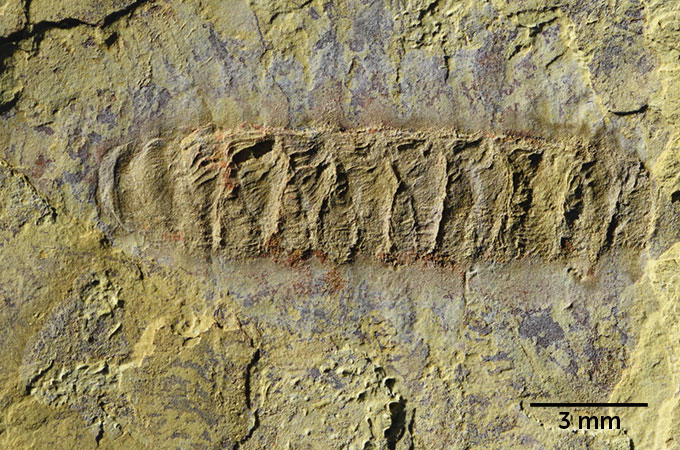An ancient, armored worm may be the key to unraveling the evolutionary history of a diverse collection of marine invertebrates.
Discovered in China, a roughly 520-million-year-old fossil of the newly identified worm, dubbed Wufengella, might be the missing link between three of the phyla that constitute a cadre of sea creatures called lophophorates.
Based on a genetic analysis, Wufengella is probably the common ancestor that connects brachiopods, bryozoans and phoronid worms, paleontologist Jakob Vinther and colleagues report September 27 in Current Biology.
“We had been speculating that [the common ancestor] may have been some wormy animal that had plates on its back,” says Vinther, of the University of Bristol in England. “But we never had the animal.”
Roughly half a billion years ago, nearly all major animal groups burst onto the scene in a flurry of evolutionary diversification during what’s known as the Cambrian explosion (SN: 4/24/19). During this time, lophophorates experienced a rapid growth of species, which has obscured the group’s evolutionary history.
 This Wufengella fossil, found in China, is roughly 520 million years old and sports several features common to sea creatures known as lophophorates.Jakob Vinther and Luke Parry
This Wufengella fossil, found in China, is roughly 520 million years old and sports several features common to sea creatures known as lophophorates.Jakob Vinther and Luke Parry
One thing that ties together the different phyla of the group is their tentacle-like feeding tubes known as lophophores. But beyond that commonality, the phyla are all quite different. Brachiopods are shelled animals that at first glance resemble clams. Bryozoans — commonly known as moss animals — are microscopic sedentary critters that live in corallike colonies. And phoronids, or horseshoe worms, are unsegmented, soft-bodied creatures that live in stationary, tubelike structures. (More recently, some researchers have determined that hyoliths — an extinct animal known by their conical shells (SN: 1/11/17) — are also lophophorates because of the tentacled organ that surrounds their mouth.)
Wufengella doesn’t belong to any of these phyla, Vinther and his colleagues found. But the critter has characteristics similar to those of brachiopods, horseshoe worms or bryozoans: a series of asymmetric, armored back plates, a wormlike body and bristles that stick out from lobes surrounding its body.

Sign Up For the Latest from Science News
Headlines and summaries of the latest Science News articles, delivered to your inbox
Client key* E-mail Address* Go
Thank you for signing up!
There was a problem signing you up.
The fossil is a “great find,” says Gonzalo Giribet, an invertebrate zoologist at Harvard University who was not involved in the research. Still, the scientists’ analysis does not confirm that Wufengella is the long-sought missing link, he cautions, but rather suggests it.
Some researchers had hypothesized that lophophorates’ common ancestor would be a stationary creature that sat on the seafloor and fed only through tubes, similar to its modern kin. The Wufengella fossil could refute this idea; the animal’s body plan suggests instead that it crawled around, the researchers say.
A fossil like Wufengella had long been high on Vinther’s bucket list of fossils that he and his colleagues hoped to find. But “we always thought, ‘Well, we probably will never see that in real life,’” he says. Typically, such a creature would have spent its life in shallow water. Organisms don’t tend to preserve well there, decaying faster due to exposure to lots of oxygen. Vinther suggests that the Wufengella that his team found probably washed out to deep water in a storm.
Now that the researchers have found one Wufengella, they hope to find more, in part to see if there are other varieties. And perhaps the team could identify even more distant ancestors further back on the tree of life that might connect lophophorates with other animal groups such as mollusks, Vinther says, further fleshing out how life on Earth is connected.

